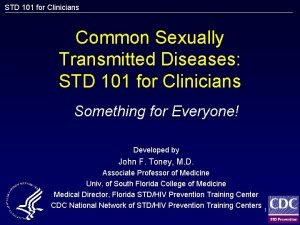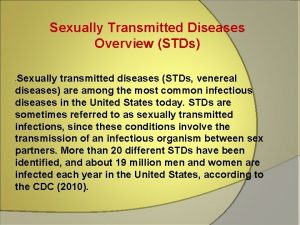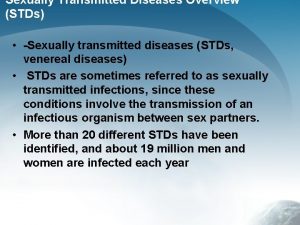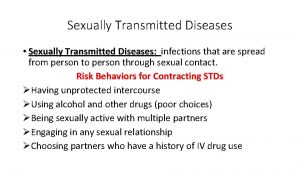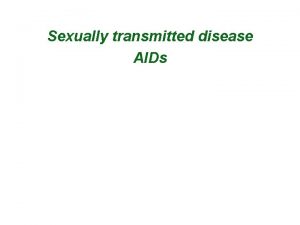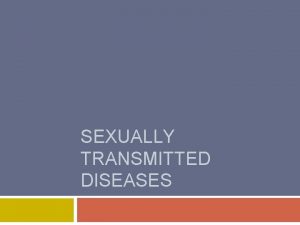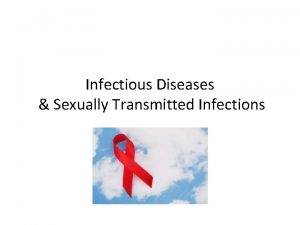UROGENITAL AND SEXUALLY TRANSMITTED DISEASES CHAPTER 20 Copyright





















- Slides: 21

UROGENITAL AND SEXUALLY TRANSMITTED DISEASES CHAPTER 20 Copyright © 2012 John Wiley & Sons, Inc. All rights reserved.

A. There are lots of mechanisms by which steroids dampen the immune response. Here a few of them: 1. Suppression of T cells. Steroids interfere with production of cytokines (like interleukins), which are critical in the proliferation and interaction of T cells. 2. Suppression of B cells. Steroids interfere with the binding of interleukins to B cells, which means that the B cells have a hard time proliferating and making antibodies. 3. Suppression of neutrophils. Steroids inhibit just about everything that neutrophils do: adhesion, chemotaxis, phagocytosis, and the release of toxic substances. 4. Suppression of macrophages. Steroids down-regulate the expression of Fc receptors on macrophages – so macrophages are less able to phagocytose opsonized things. 5. Diminished production of prostaglandins and leukotrienes. Steroids inhibit cyclooxygenase and phospholipase A 2, which decreases the production of proinflammatory arachadonic acid metabolites. Steroids are used in a ton of different immune and inflammatory disorders, like asthma, vasculitis, arthritis, gout, multiple sclerosis, sarcoidosis, alopecia areata…the list goes on and on.

Scalding Skin syndrom is caused by Streptococcus pyogenes A. True B. False

Listeria in Sabra Hummus Prompts New Wave of Recalls Two food manufacturers have issued nationwide recalls of products because of the discovery of the potentially lethal bacterium listeria, which federal authorities have now linked to three deaths and five illnesses in Texas and Kansas. On Wednesday, the Sabra Dipping Company recalled 30, 000 cases of its classic hummus after several tubs in Michigan tested positive for the food-borne bacteria. No illnesses related to the hummus have been reported so far, according to Jennifer Holton, a spokeswoman for the Michigan Department of Agriculture and Rural Development. Separately, the Centers for Disease Control and Prevention has confirmed that three people in Texas fell ill after eating Blue Bell ice cream from 2011 to 2014. The agency had already connected the company with three listeria-related deaths and two additional cases. Listeria is among the most dangerous food-borne illnesses, particularly to people with compromised immune systems, although it is much more rare than other common diseases like salmonella poisoning. The C. D. C. estimates that about 380 people die of salmonella every year, which translates to less than 1 percent of about one million annual cases. About 260 people, or about 16 percent of about 1, 600 cases, die of listeria every year. We are concerned that there may be contaminated ice cream still in people’s freezers, ” Dr. Tauxe said. “It appears that products from the Oklahoma facility may have been contaminated for some time. ” An outbreak of listeria traced to cantaloupe killed 33 people in 2011 and sickened more than 140 others. In March, a district court judge approved settlements for the families of 30 people who died.

Researchers identify antibodies to fight Marburg virus Two new studies have demonstrated how human antibodies can neutralize the Marburg virus, a highly lethal virus related to Ebola. Antibodies have been found to bind to the surface of the virus, which could lead to future antibody treatments and vaccines to target Marburg and other viruses in the family. Marburg virus is up to 90% lethal. Just like the Ebola virus, it can cause hemorrhaging and organ failure. An outbreak of the virus in Angola in 2005 was responsible for the deaths of 329 people, and the worry is that an even bigger outbreak could occur in the future. "The good news is, humans do make antibodies when they are infected that can kill these viruses. . . which suggests that vaccines should work, " says Dr. James Crowe, lead author of one of the two studies published in Cell. Due to the relationship between the Marburg and Ebola viruses, the researchers questioned whether the antibody would be able to neutralize Ebola in the same manner as this. "These cross-reactive antibodies are a straightforward route to a therapeutic, " she says. "You could use these antibodies directly against Marburg virus or - with a bit more engineering - use them to also target Ebola virus. "Part of why the viruses are so dangerous is because of how long it takes the body's immune system to effectively respond to their attack - around 4 -6 weeks. According to Dr. Crowe, antibody injections shortly after exposure could be enough to prevent illness from fully developing.

Urogenital diseases usually not transmitted sexually Urinary tract infections (UTI’s) are among the most common of all infections seen in clinical practice. Second only to respiratory infections, they account for 3 million office visits per year in the Organisms: E. coli is the causative agent in 80 percent of UTIs, but other enteric bacteria from feces can also cause such infections. When Chlamydia or Ureaplasma are responsible for infection, they usually are sexually transmitted and cause nongonococcal urethritis (NGU). Chlamydia-infection

Prostatitis-(inflammation of the prostate gland). The symptoms of prostatitis are urgent and frequent urination, low fever, back pain and sometimes muscle and joint pain. E. coli is the cause of 80 percent of the cases. Pyelonephritis- an inflammation of the kidney, is usually caused by the backup of urine and consequent ascent of microorganisms. E. coli causes 90 percent of outpatient cases and 36 percent of those in hospitalized patients Glomerulonephritis- or Bright’s disease, causes inflammation and damage to the glomeruli of the kidney’s. It is an immune complex disease that sometimes follows a streptococcoal or viral infection Toxic shock syndrome (TSS)-Infection with certain toxigenic strains of Staphylococcus auerus can produce TSS.

Sexually Transmitted Disease (STDs)

Bacterial sexually transmitted diseases Gonorrhea-The causative agent, Neisseria is a Gram-negative spherical or oval diplococcus with flattened adjacent sides and resembles a pair of coffee beans facing each other. Figure 20 -9 Diplococci of Neisseria gonorrhoeae. . Gonococci produce an endotoxin that damages the mucosa in fallopian tubes and releases enzymes such as proteases and phospholipases that may be important in pathogenesis. They also produce an extracellular protease that cleaves Ig. A, . The disease- humans are the only natural hosts for gonococci. Gonorrhea is transmitted by carriers who either have no symptoms or have ignored them. As many as 40 percent of males and 60 -80 percent of females remain asymptomatic after infection and can act as carriers for 5 to 15 years. High morbidity (about one-third of males become infected after a single sexual exposure) and 95% have pus dripping from the urethra within 14 days. As many as half of infected females develop pelvic inflammatory disease (PID), in which the infection spreads throughout the pelvic cavity. Studies done in Sweden showed that sterility often follows PID because of tubal occlusion by scarring. Disseminated infections, which occur in 1 to 3 percent of cases, produce bacteremia, fever, joint pain, endocarditis and skin lesions. Gonococcal arthritis is now the most common joint infection in people 16 to 50 years old. Newborns can acquired ophthalmia neonatorum during passage through the birth canal of an infected mother.

Within the cytoplasm of A leukocyte in a urethral smear Transmission electron microscopy (TEM) of N. gonorrhoeae Fig. 20. 9 Diplococci of Neisseria gonorrhoeae

From your text: Syphilis- is caused by he spirochete Treponema pallidum. In the U. S. syphilis is much less common than gonorrhea. However, the incidence of syphilis has, on average, been on the rise since 1960, although it has been declining steadily since 1990.

Figure 20 -13 -Primary chancres of syphilis Primary syphilis: an inflammatory response at the original entry site causes formation of a chancre , a hard, painless nondischarging lesion about ½ inch in diameter. Figure 20 -14, Signs of secondary and tertiary syphilis This type of wasting destruction can occur in the brain or cardiovascular system Secondary syphilis: symptoms appear, disappear, and reappear over a period of about 5 years, during which the patient is contagious. These symptoms include a copper-colored rash, particularly on the palms of the hands and the soles of the feet. Tertiary stage: Permanent damage occurs through various systems of the body. A wide assortment of symptoms appear including possible destruction of the brain and cardiovascular system.

Congenital syphilis occurs when the organism crosses the placenta from mother to baby. At birth or shortly thereafter, the infant shows a constellation of signs.

Nongonococcal urethritis (NGU)- is a gonorrhea-like STD caused by organism other than gonococci. Most cases are caused by Chlamydia trachomatis, but some are caused by mycoplasmas. The prevalence of chlamydial infections is greater than that of any other STDs and is increasing dramatically. Chlamydial infections. - Chlamydia trachomatis is a tiny spherical bacterium with a complex intracellular life cycle. Pelvic inflammatory disease , is a common complication of NGU as well as of gonorrhea. Surveys of pregnant women reveal that 11 percent have Chlamydia in the cervix. Chlamydia infection of the eye is the most common cause of preventable blindness in the world. Mycoplasmal infections- NGU also can be caused by Mycoplasma hominis which is frequently among the normal urogenital microflora especially in women. Another causative agent of NGU is Ureaplasma urealyticum. Between 1 and 2. 5 million people in the U. S. are infected. This organism accounts for more than half of all infections that make couples infertile. Low sperm count and poor sperm mobility have been observed in males: the organisms bind tightly to sperm and can be transmitted by them to sexual partners. Ureaplasma urealyticum is a major cause of fetal death, recurrent miscarriage, prematurity and low birth weight.

Fig. 20. 17 Chlamydia infection rates (per 100, 000 population) by sex, in the United States, 1984 -2005.

Viral sexually transmitted diseases

Herpes (HSV) infections- HSV-1 typically causes fever blisters (90% HSV 1; 10% HSV 2), whereas HSV-2 typically causes genital herpes (85% HSV 2; 15% HSV 1). Oral-genital contact from a person that has HSV 1 can result in genital infection which does not differ from that of HSV 2. The opposite is also true (transmission of HSV 2 to oral cavity) r. Women infected with genital herpes may be subject to 3 other serious problems: 1) increased risk of miscarriage, 2) delivery should be by Caesarean section and 3) infected women are at slightly higher risk for cervical cancer. Neonatal herpes- can appear at birth or up to 3 weeks after birth. Gingivostomatitis- lesion of the mucous membranes of the mouth, most common in children 1 to 3 years old. The most serious manifestation of HSV infection is herpes meningoencephalitis, which can follow a generalized herpes infection in a newborn, child, or adult. In this disease the activated virus (present in the trigeminal nerve, which supplies parts of the face and mouth) ascends along the nerve into the brain instead of moving toward to epithelial sites such as tongue or lips.

Genital warts- Condylomas or genital warts, caused by the human papillomavirus. The incidence of genital warts has increased rapidly in recent years to the extent that such warts are now among the most prevalent STDs. A special hazard of genital warts is their epidemiologic association with cervical carcinoma. Two strains of human papillomavirus, HPV-8 and HPV-16, are most likely to be found in cervical carcinomas. Genital warts are very contagious. You can get them during oral, vaginal, or anal sex with an infected partner. You can also get them by skin-to-skin contact during vaginal, anal, or (rarely) oral sex with someone who is infected. About two-thirds of people who have sexual contact with a partner with genital warts will develop warts, usually within 3 months of contact. Like many STIs, genital HPV infections often do not have signs and symptoms that can be seen or felt. One study sponsored by the National Institute of Allergy and Infectious Diseases (NIAID) reported that almost half of women infected with HPV had no obvious symptoms. If you are infected but have no symptoms, you can still spread HPV to your sexual partner and/or develop complications from the virus.

Cytomegalovirus (CMVs)- The majority of human CMV infections occur in older children and adults and go unnoticed because they do not produce clinically apparent symptoms. Fetal and infant CMV infections- In fetuses and infants, CMV infections can be life threatening because the virus disseminates widely to various organs. Fetuses become infected by viruses that cross the placenta from infected mothers. In severe CMV infections in which the fetus has been infected with large numbers of viruses intrauterine growth retardation and severe brain damage can occur. Many babies have CMV-infected cells in the inner ear and hearing loss due to nerve damage. Disseminated CMV. In severe disseminated disease, the virus can be present in many organs. When the kidneys become infected, immune complexes are deposited in the glomeruli, but renal dysfunction is rare except in renal transplants. A baby with severe birth defects due to Cytomegalovirus


 Chapter 24 sexually transmitted diseases and hiv/aids
Chapter 24 sexually transmitted diseases and hiv/aids Chapter 24 lesson 1 sexually transmitted diseases
Chapter 24 lesson 1 sexually transmitted diseases Sexually transmitted diseases
Sexually transmitted diseases Nursing management of reproductive tract infection
Nursing management of reproductive tract infection A bacterial std that usually affects mucous membranes
A bacterial std that usually affects mucous membranes Sexually transmitted disease
Sexually transmitted disease How do sponges reproduce sexually and asexually
How do sponges reproduce sexually and asexually Define a primary skin lesion and list three types
Define a primary skin lesion and list three types Chapter 6 musculoskeletal system
Chapter 6 musculoskeletal system Chapter 22 genetics and genetically linked diseases
Chapter 22 genetics and genetically linked diseases Chapter 21 mental health diseases and disorders
Chapter 21 mental health diseases and disorders Chapter 17 reproductive system diseases and disorders
Chapter 17 reproductive system diseases and disorders Chapter 15 nervous system diseases and disorders
Chapter 15 nervous system diseases and disorders Chapter 8 skin disorders and diseases
Chapter 8 skin disorders and diseases In what situation should a nail service be performed
In what situation should a nail service be performed What conditions do fungal organisms favor for growth
What conditions do fungal organisms favor for growth Cardiovascular system diseases and disorders chapter 8
Cardiovascular system diseases and disorders chapter 8 Milady chapter 8 skin disorders and diseases
Milady chapter 8 skin disorders and diseases 10 diseases of lymphatic system
10 diseases of lymphatic system Whale phylum
Whale phylum Platyhelminthes
Platyhelminthes Spider phylum
Spider phylum





